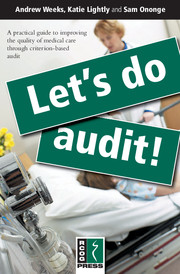 Let's Do Audit!
Let's Do Audit! Book contents
- Frontmatter
- Contents
- Acknowledgements
- Introduction
- Lesson 1 An introduction to clinical audit
- Lesson 2 Problem identification
- Lesson 3 Setting standards and establishing criteria
- Lesson 4 Measuring current practice
- Lesson 5 Analysing the data and comparing practice with agreed criteria
- Lesson 6 Implement change and re-audit
- Conclusion – let's do audit!
- References
- Appendix. Worked examples of audits
- Glossary of terms
- Index
Lesson 1 - An introduction to clinical audit
Published online by Cambridge University Press: 05 July 2014
- Frontmatter
- Contents
- Acknowledgements
- Introduction
- Lesson 1 An introduction to clinical audit
- Lesson 2 Problem identification
- Lesson 3 Setting standards and establishing criteria
- Lesson 4 Measuring current practice
- Lesson 5 Analysing the data and comparing practice with agreed criteria
- Lesson 6 Implement change and re-audit
- Conclusion – let's do audit!
- References
- Appendix. Worked examples of audits
- Glossary of terms
- Index
Summary
The word audit comes from the Latin word audire which means ‘to hear’. Through the audit process, you discover or more literally ‘hear’ what is happening in a specific area of patient care by comparing it to accepted guidelines and standards. It is only when you know exactly what is happening in that area (and what should be happening) that you can work out what is going wrong and how you can improve it (Box 1).
Box 1. The aims of audit
■ To improve patient outcomes
■ To promote the cost effective use of resources
■ To provide education
■ To empower health care staff
■ To encourage reflection on one's own practice
It is easy to be misled into thinking that you already know why there are shortfalls in patient care. However, it is only when you have properly investigated a problem through performing an audit that you can really understand the barriers to good patient care and how to overcome them.
A formal definition of clinical audit is as follows: ‘a quality improvement process that seeks to improve patient care and outcomes through systematic review of care against explicit criteria and the implementation of change’. The definition goes on to say: ‘aspects of the structure, process and outcomes of care are selected and systematically evaluated against explicit criteria. Where indicated, changes are implemented to an individual, team or service level and further monitoring is used to confirm improvement in healthcare delivery’.
- Type
- Chapter
- Information
- Let's Do Audit!A Practical Guide to Improving the Quality of Medical Care through Criterion-Based Audit, pp. 1 - 12Publisher: Cambridge University PressPrint publication year: 2010
